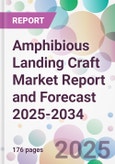The emergence of advanced weapons like hypersonic missiles, hypersonic rail guns, and directed energy weapons (DEWs) have created a need for advanced amphibious landing crafts. In both offensive and defensive military applications, the cost reduction associated with DEWs, has, in turn, boosted the applications of amphibious landing crafts. To defend against DEWs, the amphibious landing craft’s body must be integrated with heavy plate armour. This makes the amphibious landing craft voluminous, though. As a result, market vendors are increasing R&D efforts to use low-weight high-endurance materials for amphibious landing craft production.
Market Segmentation
An amphibious landing craft, which is a type of amphibious warfare ship, is primarily used to land ground forces and support it on enemy territory by an amphibious assault. Modern ships support amphibious landing craft. The global amphibious landing craft industry can be divided based on segments like type, operation, and application.Based on type, the industry is divided into:
- Landing Craft Utility (LCU)
- Landing Craft Air Cushion (LCAC)
- Amphibious Assault Vehicle (AAV)
- Others
Based on operation, the industry is divided into:
- Amphibious Operations
- Naval Operations
- Maritime Security
- Others
Based on application, the industry is segmented as:
- Vehicle Transportation
- Infantry Transportation
- Others
Market Breakup by Region
- North America
- Europe
- Asia-Pacific
- Latin America
- Middle East and Africa
Market Analysis
The global amphibious landing craft industry is being driven by the rapid technological advancements and emergence of advanced weapons. Terrorist organisations are increasingly using advanced arms to attack targets such as military convoys for surface transport. The increasing number of casualties resulting from such attacks has forced governments of different countries to procure advanced alternative transportation systems, such as AAVs (amphibious assault vehicles), for the protection of soldiers. The increasing number of troops deployed by countries like the US, Russia, and China, across their respective allies’ national borders will boost the need for specific variants of amphibious landing crafts, thus, aiding the growth of the amphibious landing craft industry. Also, near coastal regions, the extreme viability of amphibious systems has driven prominent nations to launch modernisation initiatives for their landing craft fleet. To counter emerging threats, such capacity upgrades by different countries will be a significant factor driving the growth of the market for amphibious landing craft in the forecast period.Competitive Landscape
The report presents a detailed analysis of the key players in the global amphibious landing craft market, looking into their capacity, market shares, and latest developments like capacity expansions, plant turnarounds, and mergers and acquisitions:The report gives an in-depth insight into the industry by providing a SWOT analysis as well as an analysis of Porter’s Five Forces model.








